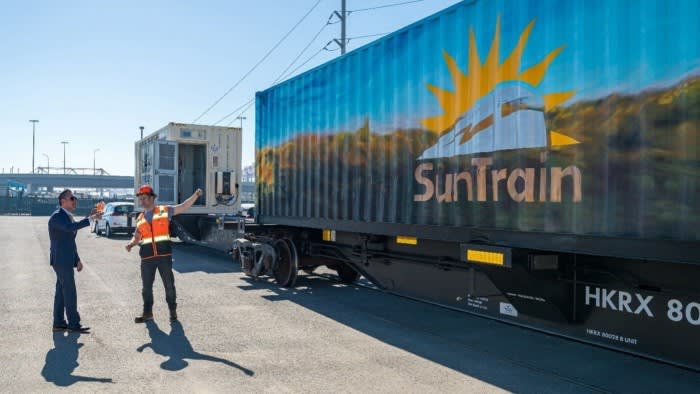Stay informed with free updates
Just log in Renewable energy myFT Digest — delivered straight to your inbox.
Christopher Smith had his epiphany while hiking in Alaska. After seeing fossil fuel railcars chugging along railroad tracks, he wondered if batteries charged by wind or solar farms could be shipped the same way. “I saw shipping containers of oil and coal and thought we could use the rail network to move green energy. That was an ‘aha’ moment,” says Smith, who then worked as an engineer with the International Brotherhood of Electrical Workers.
Determined to turn his brainchild into a business reality, Smith launched SunTrain in 2021 to explore how to ship giant battery containers to power-poor parts of the US. A large battery mounted on a flatbed car on a rail siding in the Port of San Francisco next to a small solar power installation shows how his vision is starting to materialize.
Smith explains that his venture capital-backed start-up aims to run 120-car battery-powered trains to provide renewable energy using the existing US rail network. Although declining, coal shipments still accounted for 14 percent of the 24.4 million carloads of U.S. rail traffic last year, according to the Association of American Railroads. SunTrain calculates that a battery-powered train could meet the daily energy needs of 120,000 homes. It is now signing transportation contracts with utility companies and raising $30 million to scale its operations.
Like many countries, the US has long struggled to build enough high-voltage transmission lines to meet demand: too many Nimbys and time-crunching planning permits make construction difficult. It took 17 years before builders of the 550-mile SunZia transmission line in New Mexico broke ground last September. In a report last year, the US Department of Energy predicted that interregional transmission capacity would need to increase by 114 percent by 2035 to meet even a moderate increase in demand as supply shifts to renewable energy. clean.
Alternatives have been rejected. “Imagine the windy plains of Iowa or the sunny deserts of Arizona. You can’t exactly send sunlight into a railroad car,” Bill Gates wrote last year. Only the mission-driven Smith thinks you can. ‘Transmission’, he said, could offer a cheap, flexible and profitable answer to the energy challenge that would help the planet and save rail workers’ jobs.
The idea behind SunTrain initially sounds crazy to many investors, admits Rob Carlson, managing director at Bioeconomy Capital, the company’s early-stage funder. But it makes sense when you consider the costs and timelines. “Utilities need to get electrons from point A to B. It will take at least five to 10 years less to put batteries in a box car than to build a wire,” he tells me.
Whether SunTrain can succeed at scale is unproven. But it’s an intriguing example of the possibilities of repurposing existing infrastructure, even one as neglected as the US rail network. It’s still worth making big societal bets on transformative technologies, such as nuclear fusion or quantum computing, because the potential benefits are huge. But it’s also worth imagining how best to adapt existing technology and infrastructure for more immediate impact.
Another case of reusing old technology is wind propulsion, which humans have used for six millennia. Earlier this year, Finnish company Norsepower won a contract to fit six 35m high Flettner rotary sails to a new fleet of Airbus lessees. Last year, agricultural trader Cargill chartered a vessel owned by Mitsubishi, equipped with 37.5-meter-tall rigid sails to complement its engine. Some in the industry predict that such technology could cut ships’ fuel consumption by 30 percent.
Perhaps the biggest benefits from re-imagining existing infrastructure are in the construction sector, which generates around 37 percent of global harmful emissions. A report last year by the United Nations Environment Program estimated that new buildings on the scale of Paris are being created worldwide every five days. UNEP calculates that renovating existing buildings produces between 50 percent and 75 percent less emissions than new construction.
There are some great examples of repurposed buildings: London’s Tate Modern is in a converted power station and Paris’s Musée d’Orsay is in an old train station. My favorite example of a multi-use building is Amager Bakke, part of the re-conversion of Copenhagen’s harbor area, a clean waste incineration plant with an artificial ski slope.
Journalists like me tend to obsess over anything shiny and new. Sometimes, however, there is more value in rethinking the old and messy.
john.thornhill@ft.com
